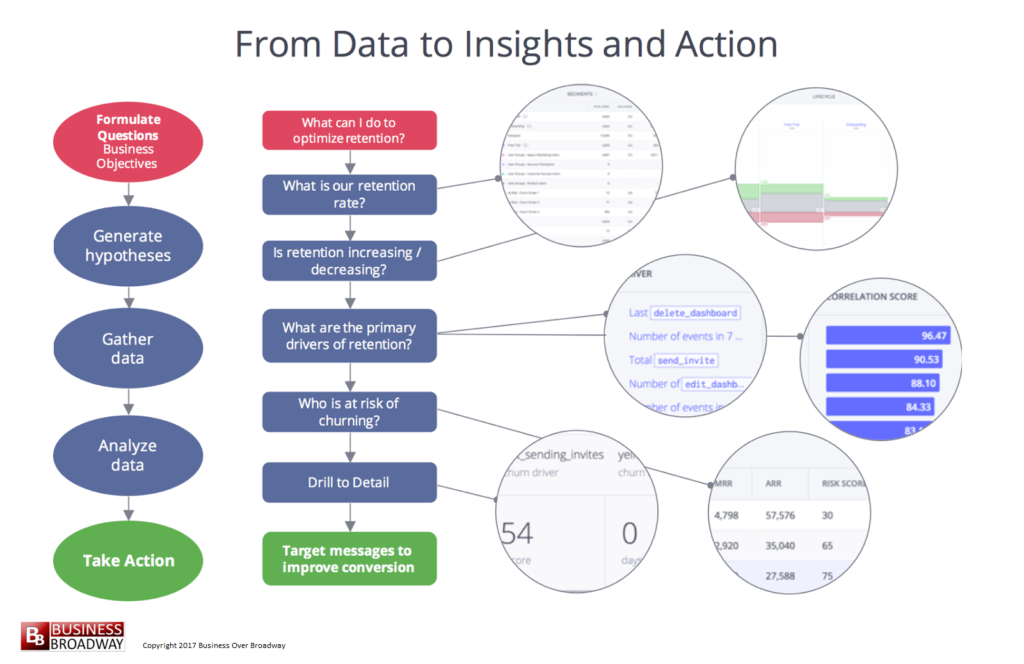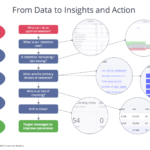Data science methods and related tools (i.g., predictive analytics, machine learning) can help companies improve their customer success programs by answering 5 important questions about customer churn, including what is the current churn/retention rate (e.g., descriptive analytics), who is at risk for churning (predictive analytics), what actions can prevent churn (i.e., prescriptive analytics) and more.
Business professionals are relying heavily on the practice of data science to answer important questions to improve how they manage customer relationships. Data scientists, in turn, utilize the power of analytics to help them extract those insights. In this post, I will highlight how data scientists leverage analytics to answer the top 5 questions customer success leaders have about their customers.
Customer Success
Customer success is the function in a company that manages the relationship it has with its customers to ensure the customers receive value from the product or solution. In today’s subscription-based economy (think software as a service – SaaS), customers are no longer trapped in long-term contracts and, consequently, have greater opportunities to cancel their subscription when they are unhappy with any aspect of the relationship. More importantly, their cancellation can occur without any advanced warning to the business.
SaaS companies are relying on their customer success professionals to mitigate the problem of customer churn. This proactive approach to customer churn necessarily relies on the analysis of data. In fact, in our recent study, we found that two-thirds of companies with formal customer programs (including customer success programs) are leveraging data scientists to help them make sense of their data.
Data Science Methods
Data science is a method of extracting insights from data. The goal of a data scientist is to derive empirically-based insights that augment and enhance human decisions and algorithms. Rather than conceptualizing data science as a body of knowledge or facts, consider it as a way to approach a problem using data. The data science approach brings three broad skills to bear on solving problems, including 1) content domain knowledge, 2) technology and programming skills and 3) math and statistics. In data-intensive projects, the application of these three skills helps you ask the right questions, access the right data and analyze the data to answer the questions, respectively.
Broadly speaking, data scientists utilize three different types of analytics when getting value from their data: 1) descriptive, 2) predictive and 3) prescriptive. The purpose of descriptive analytics is to summarize historical trends in the data that inform you about the current state of the world. The purpose of predictive analytics, on the other hand, is to predict the future or to be able to predict data that we don’t have. Prescriptive analytics relies on both descriptive and predictive analytics to help you capitalize on opportunities or mitigate risk. Here are five ways data scientists extract insights from data. Data scientists can:
- identify current state of affairs (means/percentages)
- predict what will happen in the future (regression)
- use algorithms to score people (classification)
- identify naturally occurring groups (cluster)
- identify treatments that are more/most effective (experimentation; A/B testing)
Five Most Valuable Questions about Customer Churn Asked by Customer Success Leaders

Figure 1. Data science can help customer success managers answer important questions about customer churn/retention. Click image to enlarge.
Customer success leaders need to answer important questions about churn / retention (see Figure 1). The answers to these questions help leaders understand what they need to do to ensure each customer receives value from the solutions and remain a valuable customer. These five questions and how data science can help are:
- What is our current customer churn rate? Computing your churn rate is a good first step toward understanding the health of the customer relationship and what you need to do to improve (or maintain) that health. Calculating your current churn rate helps you understand if you have a churn problem. Additionally, you can look at historical trends to gauge whether your current churn rate has improved or worsened. Finally, to know if your churn management efforts are effective tomorrow, you need to know where your churn stands today.
- What are the main causes of customer churn? To fix a customer churn problem, you first need to identify the underlying reasons why your customers are leaving you. Data science professionals, using historical data, build models to predict customer churn. These statistical models (algorithms) help quantify the degree to which different factors are responsible for customer churn. These factors could include: 1) how customers use the product, 2) customers’ interactions with the company – via support, 3) customer sentiment and more.
- Which specific customers are at risk for churning? Answering this question helps customer success leaders take a proactive approach to dealing with customer churn. They can apply the algorithmic model (question 2) to new customers to classify/identify customers who are likely to churn in the future. The model uses each customer’s information (e.g., product usage, interactions with the company, web visits) to classify each customer into one of two groups: 1) likely to stay and 2) likely to churn. Customer success leaders can use this information to reach out to at risk customers to save those relationships.
- How should we segment our customers? Traditionally, companies segment their customers based on demographic information, including geographical location, age and gender, to name a few. Now, customer success leaders, applying a data science approach, can leverage existing customer data to create empirically-derived customer segments based on their underlying value to the company. By applying cluster analysis to customer data (values, product usage, social media, etc), customer success leaders can group customers into smaller, homogeneous segments. By identifying high-value customers and what makes them tick, customer success leaders can then target prospects that match those characteristics. The hope is that bringing on new customers who are similar to your most valued, current customers will lead to higher future retention rates.
- Which marketing campaign is more effective at reducing churn? Marketing collateral can be used to attract new customers or save/incentivize existing relationships. Actual experimentation (e.g., A/B testing) can be used to test the efficacy of different marketing campaigns in reducing churn. Empirically-derived insights like this ensures that the best message or service is being delivered to the at-risk customers that will decrease their likelihood of leaving.
Answers to the above questions can then be combined to help prescribe specific responses to help improve how you manage customer relationships; prescriptive analytics will help you can craft the right marketing campaign to lift customer retention and even help you ensure customer success managers are allocating their valuable time to customers who are at-risk at leaving. It is clear that the practice of data science can answer pressing questions that can help customer success leaders use their data to act proactively to minimize customer churn.
Summary
Customer success leaders rely on the practice of data science to help answer important questions about their customers. These insights help determine how best to manage customers to reduce customer churn, from understanding the current state of customer churn to identifying the key reasons why customers leave.
While data scientists can investigate these problems manually, they often have to deal with many different types and sources of data. Instead of relying on data scientists, customer professionals are now turning to the power of machine learning in their customer data platforms that generate insights automatically. These automated machine learning-derived insights are then incorporated into existing marketing, sales and support workflows that can help you retain, engage and grow customer relationships.
Although the current post focused on applying data science methods and related tools (i.g., predictive analytics, machine learning) to the problem of customer loyalty as indexed by churn, similar questions can be asked about other customer loyalty metrics, including average revenue per customer, conversions (from free to paid) and recommendations. It’s clear that customer success leaders can obtain useful insights through the application of data science that can improve how businesses manage customer relationships.
This article first appeared on CustomerThink.




 Beyond the Ultimate Question
Beyond the Ultimate Question Measuring Customer Satisfaction and Loyalty (3rd Ed.)
Measuring Customer Satisfaction and Loyalty (3rd Ed.)
[…] the metric or metrics that are highly predictive of real loyalty behaviors (e.g., whether or not customers stayed or churned or purchased different products/services). Metrics that are highly predictive of customer churn […]